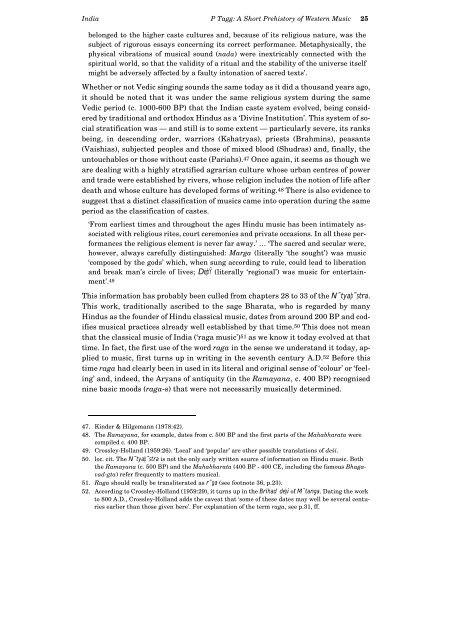A Short Prehistory of Western Music, Chapter 3
A Short Prehistory of Western Music, Chapter 3
A Short Prehistory of Western Music, Chapter 3
Create successful ePaper yourself
Turn your PDF publications into a flip-book with our unique Google optimized e-Paper software.
India P Tagg: A <strong>Short</strong> <strong>Prehistory</strong> <strong>of</strong> <strong>Western</strong> <strong>Music</strong> 25<br />
belonged to the higher caste cultures and, because <strong>of</strong> its religious nature, was the<br />
subject <strong>of</strong> rigorous essays concerning its correct performance. Metaphysically, the<br />
physical vibrations <strong>of</strong> musical sound (nada) were inextricably connected with the<br />
spiritual world, so that the validity <strong>of</strong> a ritual and the stability <strong>of</strong> the universe itself<br />
might be adversely affected by a faulty intonation <strong>of</strong> sacred texts’.<br />
Whether or not Vedic singing sounds the same today as it did a thousand years ago,<br />
it should be noted that it was under the same religious system during the same<br />
Vedic period (c. 1000-600 BP) that the Indian caste system evolved, being considered<br />
by traditional and orthodox Hindus as a ‘Divine Institution’. This system <strong>of</strong> social<br />
stratification was — and still is to some extent — particularly severe, its ranks<br />
being, in descending order, warriors (Kshatryas), priests (Brahmins), peasants<br />
(Vaishias), subjected peoples and those <strong>of</strong> mixed blood (Shudras) and, finally, the<br />
untouchables or those without caste (Pariahs). 47 Once again, it seems as though we<br />
are dealing with a highly stratified agrarian culture whose urban centres <strong>of</strong> power<br />
and trade were established by rivers, whose religion includes the notion <strong>of</strong> life after<br />
death and whose culture has developed forms <strong>of</strong> writing. 48 There is also evidence to<br />
suggest that a distinct classification <strong>of</strong> musics came into operation during the same<br />
period as the classification <strong>of</strong> castes.<br />
‘From earliest times and throughout the ages Hindu music has been intimately associated<br />
with religious rites, court ceremonies and private occasions. In all these performances<br />
the religious element is never far away.’ … ‘The sacred and secular were,<br />
however, always carefully distinguished: Marga (literally ‘the sought’) was music<br />
‘composed by the gods’ which, when sung according to rule, could lead to liberation<br />
and break man’s circle <strong>of</strong> lives; DeþŸ (literally ‘regional’) was music for entertainment’.<br />
49<br />
This information has probably been culled from chapters 28 to 33 <strong>of</strong> the N˜tyaþ˜stra.<br />
This work, traditionally ascribed to the sage Bharata, who is regarded by many<br />
Hindus as the founder <strong>of</strong> Hindu classical music, dates from around 200 BP and codifies<br />
musical practices already well established by that time. 50 This does not mean<br />
that the classical music <strong>of</strong> India (‘raga music’) 51 as we know it today evolved at that<br />
time. In fact, the first use <strong>of</strong> the word raga in the sense we understand it today, applied<br />
to music, first turns up in writing in the seventh century A.D. 52 Before this<br />
time raga had clearly been in used in its literal and original sense <strong>of</strong> ‘colour’ or ‘feeling’<br />
and, indeed, the Aryans <strong>of</strong> antiquity (in the Ramayana, c. 400 BP) recognised<br />
nine basic moods (raga-s) that were not necessarily musically determined.<br />
47. Kinder & Hilgemann (1978:42).<br />
48. The Ramayana, for example, dates from c. 500 BP and the first parts <strong>of</strong> the Mahabharata were<br />
compiled c. 400 BP.<br />
49. Crossley-Holland (1959:26). ‘Local’ and ‘popular’ are other possible translations <strong>of</strong> deši.<br />
50. loc. cit. The N˜tyaþ˜stra is not the only early written source <strong>of</strong> information on Hindu music. Both<br />
the Ramayana (c. 500 BP) and the Mahabharata (400 BP - 400 CE, including the famous Bhagavad-gta)<br />
refer frequently to matters musical.<br />
51. Raga should really be transliterated as r˜ga (see footnote 36, p.23).<br />
52. According to Crossley-Holland (1959:29), it turns up in the Brihad deþi <strong>of</strong> M˜tanga. Dating the work<br />
to 800 A.D., Crossley-Holland adds the caveat that ‘some <strong>of</strong> these dates may well be several centuries<br />
earlier than those given here’. For explanation <strong>of</strong> the term raga, see p.31, ff.














